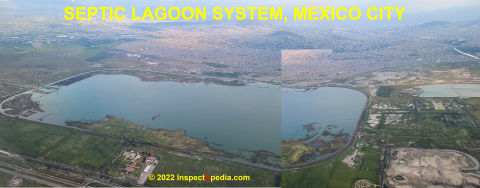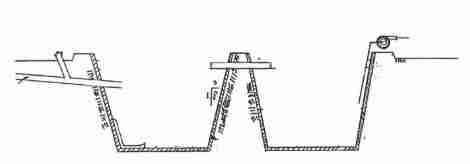 Sewage Lagoons for Onsite Wastewater Treatment
Sewage Lagoons for Onsite Wastewater Treatment
- POST a QUESTION or COMMENT about wastewater treatment lagoons
Guide to lagoon systems for septic wastewater treatment: design, use, maintenance, life, effectivenes. Lagoon septic systems: also known as "pond septic systems" for onsite wastewater treatment are less often found in use for single family residential wastewater treatment.
A residential lagoon system may use a conventional septic tank, but effluent from the tank flows to a storage pond or lagoon for further treatment. The illustration at page top is from "Utah Small Animal Waste Lagoons and Ponds" published by the Utah state government.
InspectAPedia tolerates no conflicts of interest. We have no relationship with advertisers, products, or services discussed at this website.
- Daniel Friedman, Publisher/Editor/Author - See WHO ARE WE?
Sewage Lagoons or Ponds for Onsite Waste and Wastewater Treatment
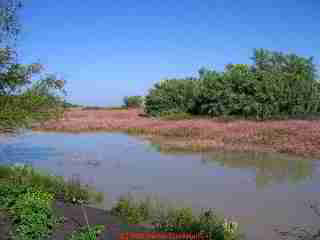 What is a Lagoon Septic System for Onsite Waste or Wastewater Treatment?
What is a Lagoon Septic System for Onsite Waste or Wastewater Treatment?
 What is a Lagoon Septic System for Onsite Waste or Wastewater Treatment?
What is a Lagoon Septic System for Onsite Waste or Wastewater Treatment?Lagoon systems: also known as "pond systems" for onsite wastewater treatment are less often found in use for single family residential wastewater treatment.
A residential lagoon system may use a conventional septic tank, but effluent from the tank flows to a storage pond or lagoon for further treatment. (Some states such as Missouri may permit a lagoon without a septic tank.)
Lagoon systems require comparatively large land areas and are more likely to be found therefore in rural areas or where a common wastewater treatment system has been designed to serve multiple dwellings.
For example lagoons are used for effluent disposal on small farms and for animal waste treatment/disposal on small and large farms or livestock operations.
[Click to enlarge any image]
Aerobic Lagoon Wastewater Treatment System Design
The lagoon or pond holds septic effluent where treatment may be enhanced by using an aerobic design to a shallow pond of effluent (adding air to the water, perhaps by an air pump or a fountain system).
Anaerobic Lagoon or Pond Septic System Designs
Anaerobic lagoon or pond designs are deeper and work more like a conventional septic tank, processing waste into settled sludge and treated effluent, and not making use of oxygen-requiring microbes nor of sunlight to treat the effluent.
Effluent from a pond septic system, except for its portion which is removed by evaporation, is commonly permitted to flow through a wetlands for further treatment before discharge to the environment.
The site and construction requirements for a lagoon septic system will require additional clearance distances from wells, property lines, etc. Lagoons are constructed in high clay soils (or lined) so that effluent does not drain into the soil directly from the lagoon.
A Typical Residential Wastewater Lagoon Design Specifications
Septic Lagoon Size
The enormous wastewater treatment lagoon shown above is part of the wastewater treatment system serving Mexico City and is adjacent to MEX, the Benito Juarez Airport, serving the Zona Metropolitana del Valle de México, an area of more than 19 million people.
North Dakota State University offers some basic design specifications for a lagoon system for treating wastewater: "The lagoon surface area should be sized at about 500 square feet per person.
A lagoon serving a four-person household would then have a surface area of about 2,000 square feet. The lagoon should have a depth of 3 feet with a minimum freeboard of 2 feet.
Nebraska Title 124 Ch. 18.008 provides these septic lagoon sizing specifications
008.01 The size of a lagoon shall be based on the design flow for the dwelling or non-dwelling facility, the seepage rate of the wastewater into the soil below the lagoon, and the average evaporation and precipitation using the appropriate location on the state evaporation and precipitation maps (Figures 18.1 and 18.2).
008.01A For a dwelling, the minimum wastewater flow for design of the onsite system shall be based on the number of bedrooms in the dwelling using the following: 150 gpd + ((Number of Bedrooms - 1) x 75 gpd), where gpd is gallons per day.
008.01B For a non-dwelling structure or other wastewater source, the wastewater flow shall be based on the highest daily wastewater flow.
008.02 The lagoon water surface area at the maximum operating level shall be determined by the following water balance equation:
Maximum Water Surface Area = (flow) x 976 / ((evap.-precip.)x1.67) + OOD) + (seepage x .608)
Where:
flow = daily design flow or inflow, gallons per day
evap. = annual lake evaporation for location from Fig. 18.1(This is a state map showing necessary data)
precip. = annual precipitation for location from Fig. 18.2 (This is a state map showing necessary data)
OD = difference between maximum and minimum operating depths for the lagoon (typically three feet which is also the maximum allowed)
Note that assumptions such as evporation rate and precipitation rate vary widely seaonally and by geographic area while seepage rates or soil percolation rates vary widely by soil properties as well.
Where septic lagoon wastewater treatment systems are permitted and regulated by code, most authorities also describe the soil percolation rate or seepage rate test procedure to be sued in evaluating the site for lagoon operation.
Septic Lagoon Shape
Shape the sides of the lagoon to a 3:1 slope. A 2,000 square foot lagoon with 3 feet working depth and 3:1 side slopes would have a 50-foot diameter at its working depth and a 62-foot diameter at the top of the dike.
The lagoon may also be square or rectangular. A 2,000 square foot lagoon would be 45 feet square at its working depth and 57 feet square at the top of the dike." --quoted from North Dakota State University - www.ag.ndsu.edu/pubs/ageng/structu/ae892-3.htm#Lagoons.
The design specifications for a lagoon septic system will vary widely depending on its use and the effluent flow rate involved. However the basic concepts of lagoon system operation and protection will be consistent.
Septic Lagoon Construction Details
Nebraska Title 124 Ch. 18 septic lagoon construction details
provides a crisp desription
001 A site for a lagoon shall permit the unobstructed wind to sweep across the lagoon to provide mixing action and to add oxygen to the water. Timber must be removed for a horizontal distance of at least 50 feet as measured from the high water mark for the maximum operating depth of the lagoon, but not less than 10 feet horizontal distance from the outer dike toe of the lagoon.
002 The lagoon shall be located and constructed so it will not receive surface runoff water.
003 A lagoon shall not be installed on a lot less than three acres in size. For the purpose of this chapter, “lot size” means the area of a lot excluding all area below the normal high water level of any surface water feature and all area within the right-of-way or easement of a street, road, or access easement.
004 The lagoon shall be designed for complete retention.
005 The floor of the lagoon shall be located at least two feet above the seasonal high groundwater level, bedrock, or other barrier layer.
006 The top of the dike shall be at least one foot above the 100 year flood elevation.
007 Testing of the final seepage rate shall be completed based on soil permeability.
The maximum allowable seepage rate is one-eighth inch per day after sealing and compaction. This may be determined by an independent soils laboratory performing a hydraulic conductivity test on an undisturbed soil sample taken at the site, or the two barrel method prior to filling, or a comparison test after prefilling with clean water but before introduction of wastewater.
007.01 The two barrel method may be used for soil sealed lagoons before the lagoon is filled.
Two similar 55 gallon drums are required, one a control drum with one end removed and the other drum (seepage drum) with both ends removed. One end of the seepage drum is pressed into the sealed soil layer, and a bead of polymer treated sodium bentonite clay is packed around the inside edge of the drum.
The seepage drum is carefully filled with water and kept filled for two or more days to saturate the soil. The test begins with filling each drum equally.
Each day the difference in levels is recorded, and the barrels filled to the beginning level. The control drum measures the weather effects while the seepage drum records seepage plus weather effects. The test should continue for at least seven days.
007.02 The comparison test method may also be used after the lagoon is prefilled
Isolate the lagoon and record the water level changes as a result of seepage and weather effects. The changes resulting from weather effects alone may be measured separately in a nearly full white plastic five gallon bucket partially buried near the shore. The test should continue for at least seven days.
Nebraska Title 124 Ch. 18.012 further specifies:
009 Septic Lagoon Construction
009.01 The floor of the lagoon shall be level. A difference of plus (+) or minus (-) three inches is permitted. All vegetation shall be removed from the floor of the lagoon. This organic material shall not be used in the construction of the lagoon.
009.02 The soil material of the lagoon floor shall be designed so that it shall not seep more than one-eighth inch per day. If soil borings and tests indicate that the existing soils are not conducive to compaction to meet this requirement, then sodium bentonite clay or a synthetic liner may be used to restrict seepage.
009.03 The inside slope of the dikes shall not be steeper than three horizontal to one vertical. The exterior slope of the dikes shall not be steeper than four horizontal to one vertical. The minimum width of the top of the dike shall be four feet.
010 The minimum operating depth of the lagoon shall be two feet. The maximum operating depth shall be five feet. The dikes shall provide a minimum freeboard of 12 inches.
Site clearance distances for septic lagoon systems
Table of Typical Lagoon Septic or Sewage Lagoon Clearance Distances |
||
| Site Feature | Minimum Distance to Lagoon | Minimum Distance to Septic Tank |
| Basement | 100 ft. | 15 ft. |
| Building Foundation, on-site | 100 ft. | 5 ft. |
| Building Foundation, neighouring site | 200 ft. | |
| Cistern | 25 | 25 |
| Impoundment 4 | 100 | 50 |
| Interceptor drain - runoff control up-slope | 10 | |
| Interceptor drain - runoff control down-slope | 25 | |
| Lake 4 | 100 | 50 |
| Property boundary or line | 75 | 10 |
| Property line to lagoon overflow drain 9 | 100 | n/a |
| Septic drainfield, soil absorption system 5 | 20 | |
| Sinkhole, nearest edge, surficial 6 | 500 | 50 |
| Spring used for water supply | 100 | 50 |
| Stream - waterway 4 | 100 | 50 |
| Stream, open drainage ditch | 25 | 25 |
| Swimming pool - in ground? | 100 | 15 |
| Tall grasses, tall weeds | 50 | |
| Trees 7 | 50 | |
| Water supply pipe or line, pressurized | 10 | 10 |
| Water supply pipe or line, suction (jet pump) | 100 | 50 |
| Well: private | 100 | 50 |
| Well: public water supply | 300 | 300 |
Notes to the table above:
These distances are from the lagoon to the feature listed, are not the same as clearance distances from the septic tank itself. Our table gives example distances for both.
Setback distances from a lagoon septic to other site features are similar to setbacks from other septic system designs and are elaborated in detail by Schultheis (1997) from which we excerpt some examples. Additional details are from the University of Missouri Exension ctied below.
- Includes sewage tanks, intermittent sand filters and dosing chambers
- Unplugged abandoned wells, or wells with less than 80 feet of casing depth shall have 150 feet minimum setback distance from all above.
- A classified stream is any stream that maintains permanent flow or permanent pools during drought periods and supports aquatic life.
- Sewage tanks and soil absorption systems should never be located in the drainage area of a sinkhole.
- Soil absorption system distance excludes repair area or reserved area
- In our opinion lagoon septics should not be constructed at all in areas known to be close to sinkhole formations
- Trees should be 50 ft. or more from the edge of the lagoon water
Trees and high weeds should be located at least 50 feet from the water's edge. This will allow the lagoon to receive direct sunlight, let breezes help stir oxygen into the water as they blow across the lagoon, and keep leaves from falling into the water, causing sludge buildup. [MO DOH] - Site slope: Sites with more than 5 to 7 percent slope (5 to 7 feet of elevation drop per 100 feet of horizontal distance) should generally be avoided for lagoon construction. [MO DOH]
- To allow for future development in the area, carefully select the location of the lagoon overflow so that it will be of the least nuisance to both the owner and to neighbors or nearby public properties. [MO DOH]
- See SEPTIC CLEARANCE DISTANCES for a more complete list of septic system clearance distances
Safety Barriers & Fencing at Septic Lagoons
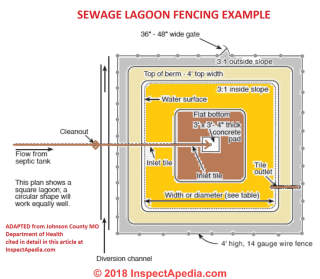 Lagoon Wastewater System Safety and Protection: Fencing
Lagoon Wastewater System Safety and Protection: Fencing
For safety the edges of a lagoon should be fenced to protect children and animals.
Protection may also be needed to keep burrowing animals such as groundhogs from digging holes which inadvertently drain the pond.
Also see GOPHER HOLE DAMAGE
The lagoon shall be fenced with a four foot high woven wire, welded wire, or seven strand barbed wire with the first strand starting three inches from the ground and the following strands spaced evenly.
The fence shall be equipped with a standard main gate that is kept locked.
The fence shall be placed on the outside edge of the top of the dike or four feet outside the toe of the dike.
A sign no less than 12 inches by 24 inches bearing the clearly-readable words
NO TRESPASSING - WASTEWATER LAGOON
shall be located on the gate. - NE Title 124 Ch. 18.012
Other specifications require the following additional details:
The septic or sewage lagoon fencing access gate must be kept intact and locked.
The following tect and illustration above are adapted from the sewage or septic lagoon fencing specification described by the Johnson County MO department of health, cited in detail below,
THE FENCE MUST BE IN PLACE PRIOR TO USE OF THE LAGOON!
The fence must be at least 4 feet in height, be welded, woven or chain link material with no smaller than fourteen gauge wire.
Cattle or hog panels can be substituted with tee post being used for a line post. Fence post shall be pressure-treated wood, galvanized and or painted steel. Line posts should be at least 18 inches deep and not spaced more than 10 feet apart.
Corner posts should be at least 24 inches deep and properly braced.
The gate may be substituted with a cattle or hog panel that is allowed to open for mowing and maintenance, but must be secured with an effective latching device.
The fence shall be no closer than the center of the berm to the water’s edge. The fence shall be of sound construction with no gaps or openings along the bottom. - MO DOH cited below
Sewage Lagoon Overflow Regulation
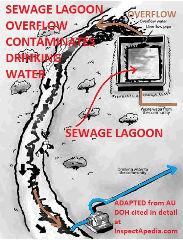 Some authorities specify the handling of sewage lagoon overflows, either prohibiting lagoon overflow by design specifications, or by specifying where overflow is permitted.
Some authorities specify the handling of sewage lagoon overflows, either prohibiting lagoon overflow by design specifications, or by specifying where overflow is permitted.
The following is adapted from Australia's Department of Health Sewage Lagoon regulations (2011) cited below.
Where there is only one lagoon in the sewage disposal system, it will have an overflow situated directly opposite where the pipe carrying the sewage or effluent enters the lagoon.
If there is more than one lagoon in the system, the overflow will be in the last lagoon.
The overflow releases water from the lagoon system which has not been removed by evaporation.
New lagoon systems are required to be designed so disposal occurs by evaporation only.
They should not rely on overflow, except during very heavy rainfall periods.
However, where an existing lagoon system uses an overflow method, the overflow should not create a flooded or swampy area suitable for mosquito breeding, or where it may contaminate drinking water or the environment. (AU DOH 2011)
Watch out: The Australian DOH illustration shown here explains how sewage lagoon overflow can contaminate a community drinking water supply. Don't do this.
Lagoon Wastewater Treatment System Inspection & Maintenance
Our description of the maintenance requirements for septic lagoon systems has been relocated to LAGOON SEPTIC MAINTENANCE
Lagoon Wastewater Treatment System Installation & Maintenance References & Guides
- LAGOON SEPTIC SYSTEMS - home
- LAGOON SEPTIC MAINTENANCE - separate article
- LAGOON SEPTIC EFFECTS of GARBAGE GRINDERS ON
- SEWAGE LAGOONS [PDF] - Australian publication
- VEGETATED SUBMERGED SEPTIC BEDS
- WETLAND SEPTIC SYSTEMS
- Australia Department of Health, SEWAGE LAGOONS [PDF] (2011), retrieved 2019/01/26, original source: http://www.health.gov.au/internet/publications/publishing.nsf/Content/ohp-enhealth-manual-atsi-cnt-l~ohp-enhealth-manual-atsi-cnt-l-ch2~ohp-enhealth-manual-atsi-cnt-l-ch2.11
- Dowson, Greg, Daniel Ray, Dao Norath, DESIGN and MANAGEMENT of TASMANIAN SEWAGE LAGOON SYSTEMS [PDF] (1996) Tasmanian Department of Environment and Land Management (DELM) Environment Tasmania, GPO Box 1396P, Hobart, Tasmania 7001 Australia, Tel: 03 6233 6518, retrieved 2019/01/26 original source: https://epa.tas.gov.au/documents/design_and_managment_of_tas_sewage_lagoon_systems_1996.pdf
- EPA. South Australia, WASTEWATER and EVAPORATION LAGOON CONSTRUCTION [PDF] (2004), Environmental Protection Authority, GPO Box 2607, Adelaide SA 5001 Australia, Email: epainfo@state.sa.gov.au Tel: 08-8204-2004 or Freecall 1800 623 445, Website: www.epa.sa.gov.au retrieved 2019/01/26 original source: http://www.bvsde.paho.org/bvsaar/fulltext/guide_lagoon.pdf
Excerpts:
EPA 509/04—This guideline advises those proposing to construct a wastewater or evaporation lagoon on construction techniques that should assist in meeting obligations under the Environment Protection Act 1993 and the Environment Protection (Water Quality) Policy 2003. It replaces EPA Guideline 402/02, ‘Wastewater lagoon construction’.
Persons intending to construct wastewater and evaporation lagoons should also have regard to the requirements and provisions of the Development Act 1993 (and Regulations), the development plan for the area, and the Planning SA Draft Advisory Notice no. 5—Consent Requirements for Dams (www.planning.sa.gov.au/pub-pdf/479p.pdf). - EPA, U.S. WASTEWATER LAGOON CONSTRUCTION [PDF] (2018)
Excerpt:
EPA 509/18: This guideline replaces Wastewater and evaporation lagoon construction (2004). It advises those proposing to build wastewater lagoons on construction techniques that should assist in meeting obligations under the Environment Protection Act 1993 and relevant Environment Protection Policies. The guideline is intended for wastewater lagoon proponents and their engineers or consultants. - EPA, U.S., ONSITE WASTEWATER TREATMENT SYSTEMS MANUAL (2002) [web article series and original PDF] at InspectApedia.com
- EPA, U.S., UPGRADING [SEWGE] LAGOONS [PDF] (1973), U.S. Environmental Protection Agency
- Fallowfield, HJ; NJ Cromar and LM Evison (1996): Coliform Die-off Rate Constants in a High Rate Algal Pond and the Effect of Operational and Environmental Variables. Water Science and Technology 34, 133-140
- Fallowfield, HJ and MK Garrett (1996): Treatment of Wastes by Algal Culture in Microbial Aspects of Water Management (Eds CR White and SM Passmore) Society of Applied Bacteriology, Symposium Series No 14, Journal of Applied Bacteriology, 59, (suppl) 187s-250s
- Golueke, Clarence G., William Joseph Oswald, and Harold Benedict Gotaas. "Anaerobic digestion of algae." Applied microbiology 5, no. 1 (1957): 47.
- Robert A. Schultheis, "Residential Sewage Lagoon Systems: A Homeowner's Guide to Installation and Maintenance", University of Missouri, Extension Agricultural Engineering, (1997), Retrived 3/24/2014, original source: http://extension.missouri.edu/p/WQ402 and http://extension.missouri.edu/explorepdf/envqual/wq0402.pdf
- Kansas DHE, WASTEWATER POND (LAGOON) SIZING & CONSTRUCTION GUIDE DRAFT [PDF] (2002) retrieved 2019/01/26 original source: http://www.kdheks.gov/nps/lepp/ChIXLagoons.pdf
- Missouri, Johnson County DOH, WASTEWATER LAGOON FENCE LOCATION AND SPECIFICATIONS [PDF], 723 PCA Rd, Warrensburg, MO 64093 Tel (660) 747-6121retrieved 2019/01/26 original source: http://johnsoncountyhealth.org/wp-content/uploads/2014/12/LagoonFencingRequirements050708.pdf
- Missouri, U.M. Extension Residential Sewage Lagoon Systems: A Homeowner's Guide to Installation and Maintenance [PDF] retrieved 2019/01/26 original source: https://extension2.missouri.edu/wq402
- Nebraska DEQ, "Maintenance of Septic Systems and Lagoons Fact Sheet", (2003), retrieved 3/28/2014, original source: http://www.deq.state.ne.us/Publica.nsf/pages/12-031
- "Residential Lagoon System Operation & Maintenance", University of Nebraska-Lincoln, retrieved 3/282014, original source: http://water.unl.edu/sewage/lagoon-maintenance
- Nebraska "Title 124, Rules And Regulations For The Design, Operation And Maintenance of Onsite Wastewater Treatment Systems", retrived 3/29/14, original source: http://deq.ne.gov/RuleAndR.nsf/Pages/124-TOC. Title 124 Chapter 18 describes regulations for septic lagoon systems. Nebraska Department of Environmental Quality 1200 "N" Street, Suite 400 P.O. Box 98922 Lincoln, Nebraska 68509 (402) 471-2186
- "Lagoon Sewage Treatment Systems - It's Your On-Site System, Operation & Maintenance Guide for Homeowners", OKLAHOMA DEPARTMENT OF ENVIRONMENTAL QUALITY ENVIRONMENTAL COMPLAINTS AND LOCAL SERVICES P.O. Box 1 677 Oklahoma City, OK 73101 - 1677 (405) 702 - 6100, retrieved 3/28/14, original source: http://www.deq.state.ok.us/eclsnew/Fact%20Sheets%20ECLS/ System%20Fact%20Sheets/Lagoon-.pdf
- "Maintaining Your Onsite Wastewater Lagoon System", Watershed Center Committee for the Ozarks, retrievd 3/28/14, source: http://watershedcommittee.org/wp-content/uploads/2012/05/Lagoon-System.pdf
- Bobay, Keith E., USGS, GROUND WATER FLOW and QUALITY BENEATH SEWAGE-SLUDGE LAGOONS and a Comparison With the Ground Water Quality Beneath a Sludge-Amended Landfill, Marion County Indiana, U.S. Geological Survey, Water-Resources Investigations Report 88-4175, retrieved 2019/01/25 original source: https://pubs.usgs.gov/wri/1988/4175/report.pdf
- Wolverton, B. C., and Rebecca C. McDonald. "Upgrading facultative wastewater lagoons with vascular aquatic plants." Journal (Water Pollution Control Federation) (1979): 305-313.
- Additional citations pending review] also see addtional citations atReferences or Citations
Citation of this article by reference to this website and brief quotation for the sole purpose of review are permitted.Citation of this article by reference to this website and brief quotation for the sole purpose of review are permitted.
Use of this information at other websites, in books or pamphlets for sale is reserved to the author. Technical review by industry experts has been performed and comments from readers are welcomed. Contributors are listed at the end of each article.
...
Continue reading at LAGOON SEPTIC MAINTENANCE or select a topic from the closely-related articles below, or see the complete ARTICLE INDEX.
Or see these
Recommended Articles
Suggested citation for this web page
LAGOON SEPTIC SYSTEMS at InspectApedia.com - online encyclopedia of building & environmental inspection, testing, diagnosis, repair, & problem prevention advice.
Or see this
INDEX to RELATED ARTICLES: ARTICLE INDEX to SEPTIC SYSTEMS
Or use the SEARCH BOX found below to Ask a Question or Search InspectApedia
Ask a Question or Search InspectApedia
Questions & answers or comments about finding, using, diagnosing, repairing, or replacing water pressure gauges on private well systems.
Try the search box just below, or if you prefer, post a question or comment in the Comments box below and we will respond promptly.
Search the InspectApedia website
Note: appearance of your Comment below may be delayed: if your comment contains an image, photograph, web link, or text that looks to the software as if it might be a web link, your posting will appear after it has been approved by a moderator. Apologies for the delay.
Only one image can be added per comment but you can post as many comments, and therefore images, as you like.
You will not receive a notification when a response to your question has been posted.
Please bookmark this page to make it easy for you to check back for our response.
IF above you see "Comment Form is loading comments..." then COMMENT BOX - countable.ca / bawkbox.com IS NOT WORKING.
In any case you are welcome to send an email directly to us at InspectApedia.com at editor@inspectApedia.com
We'll reply to you directly. Please help us help you by noting, in your email, the URL of the InspectApedia page where you wanted to comment.
Citations & References
In addition to any citations in the article above, a full list is available on request.
- In addition to citations & references found in this article, see the research citations given at the end of the related articles found at our suggested
CONTINUE READING or RECOMMENDED ARTICLES.
- Carson, Dunlop & Associates Ltd., 120 Carlton Street Suite 407, Toronto ON M5A 4K2. Tel: (416) 964-9415 1-800-268-7070 Email: info@carsondunlop.com. Alan Carson is a past president of ASHI, the American Society of Home Inspectors.
Thanks to Alan Carson and Bob Dunlop, for permission for InspectAPedia to use text excerpts from The HOME REFERENCE BOOK - the Encyclopedia of Homes and to use illustrations from The ILLUSTRATED HOME .
Carson Dunlop Associates provides extensive home inspection education and report writing material. In gratitude we provide links to tsome Carson Dunlop Associates products and services.


